RBA Annual Conference – 1989 The Relationship Between Financial Indicators and Economic Activity: 1968–1987 Michele Bullock, Dirk Morris and Glenn Stevens
Abstract
This paper examines the relationship between a number of financial indicators and economic activity over the past two decades. The evidence for monetary and credit aggregates is mixed. M1 tends to lead private spending (though this is probably not independent of interest rates). Other bank-based aggregates sometimes led in the 1970s, but no longer do so; the relationship for these aggregates has at times been unstable. Broader monetary and credit aggregates tend to lag spending.
One consistent theme which comes through in the results is that interest rates are a reasonably good leading indicator of changes in demand, particularly real demand. This relationship has not weakened with deregulation; indeed, the statistical evidence suggests that it has strengthened.
1. Introduction
This paper examines the relationship between movements in various financial indicators and movements in measures of economic activity. The financial indicators include interest rates and a range of financial aggregates; the measures of activity are confined to changes in real and nominal private final expenditure. The study is based on quarterly Australian data over the past two decades. It is, therefore, mostly concerned with short to medium-term relationships.
The relationship between financial variables and economic activity can be examined in a variety of ways. One common approach has been to estimate simple demand functions for money, or to examine various measures of the velocity of circulation. Other approaches involve more sophisticated single-equation techniques, or full-system econometric modelling. Most of these have been used in the Bank over recent years.[1]
The present paper is less ambitious than those studies. It is essentially an exercise in data exploration and description, and it uses two simple and direct empirical techniques: graphical comparison of the movements in financial variables (interest rates and financial aggregates) with movements in private demand, and simple correlation coefficients of the same variables. The aim is to see which variables have had a reasonably reliable relationship with private demand over the four business cycles that have occurred over the past two decades, and to see the degree to which movements in financial variables lead or lag movements in private demand. The paper focuses first on the extent to which changes in real private demand are associated with changes in financial conditions. While traditional monetary theory suggests that changes in, for example, the nominal quantity of money have no lasting effect on real activity, it is widely accepted that financial variables can affect real demand in at least the short run.
To complete the analysis, the same set of comparisons and tests are also conducted for nominal private demand. This allows for the possibility that the timing of the relationship between financial variables and private demand might be different for the quantity and price components.
The paper does not, however, attempt to explain how financial institutions react to varying financial conditions or to changes in monetary policy. Nor does it spell out the transmission mechanism by which a change in monetary policy affects financial variables, and real activity and prices. These subjects will be covered in later papers which draw on the data and empirical evidence contained in the present study. In fact, the paper says very little about causality. The aim is more limited: to examine the properties of the financial variables as indicators of economic activity.
As well as looking at average relationships over the two decades, the paper also looks at whether the relationships have changed. Over the past two decades, the Australian financial system has moved from being heavily regulated to being largely deregulated. Many of the relationships which held during the early, heavily-regulated part of the period might have changed by the end of the period, when substantial deregulation had taken place.
The paper is in seven sections. The next section describes the variables examined in the paper. Section 3 contains graphical analysis of how the financial variables have moved relative to real private demand. Section 4 supplements this with some simple statistical correlations. Sections 5 and 6 repeat this analysis for nominal private demand. The conclusions are given in Section 7. An appendix gives details of data and material not covered in the text.
2. The Indicators
(a) Indicators of Economic Activity
There is a range of indicators of economic activity which might be used in a study such as this. Previous Australian empirical work[2] has used industrial production, labour force data, national accounts aggregates or combinations of variables as reference cycles.
In the present paper, to keep the analysis manageable, and to relate the financial indicators to easily recognisable and accessible indicators, attention is confined to national accounts aggregates. In particular, it concentrates on measures of private final spending (i.e. private consumption and investment, including dwelling investment).
Another possible indicator of activity is GDP. Figure 1 shows GDP and private demand, both in real terms, over the twenty-year period 1968–1987. The line in the upper part of each panel shows an index of the level. The line in the lower part of each panel shows quarterly growth, and the bars a smoothed series[3] for the growth rate.
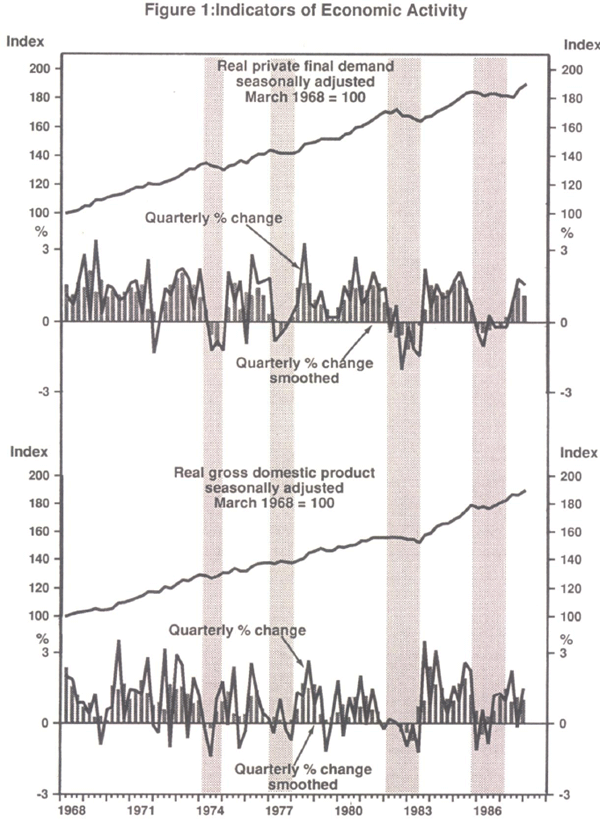
A couple of similarities between the two measures are clear: the series grew at similar rates over the period as a whole (average annual rates in excess of 3 per cent); both encountered temporary interruptions to the upward trend (the shaded areas represent periods of decline in private demand). But there are important differences. From Figure 1, downturns in demand are invariably more severe, and usually longer lasting, than those in GDP.
It might be argued that GDP is more appropriate than private demand, since it is a more complete measure of activity. On the other hand, because it is a broader measure, it also reflects many other factors besides financial conditions. In particular, net exports, government spending and farm production all have important influences on GDP, but are likely to show little short-run relationship to domestic financial conditions. Accordingly, the reference cycle used in the remainder of this paper is growth in private demand.[4] The smoothed growth rate (bars in Figure 1) is used for the graphical comparisons, and the actual growth rate for the correlations.
There were four major interruptions to the upward trend in private demand – in 1974/75, 1977/78, 1982/83 and 1985/86. In each period there were several quarters in which private demand declined. These periods are usually accepted as recessions. There were two other episodes of slowing in growth – in 1971/72 and 1978/79. Although in the first episode there was one quarter of negative growth, in the second episode there were none; in neither period did the smoothed series for domestic demand show a fall. There was also one isolated fall in private demand in the fourth quarter of 1975, but this is probably best regarded as an aberration because the periods immediately to either side showed strong quarterly growth rates.
(b) Financial Indicators
The financial variables used in the study are of three types – interest rates, banking aggregates, and broader financial aggregates that include the liabilities or assets of both banks and non-bank financial institutions.
(i) Interest Rates
The study uses short-term interest rates as one indicator of financial conditions. Figure 2 illustrates the 90-day bill rate, the weighted average rate on banks' certificates of deposit, and the weighted average rate paid by authorised dealers in the short-term money market on overnight deposits. Clearly, for most of the period, these rates move together. Accordingly, only one interest rate variable is used – the yield on 90-day bank-accepted bills (henceforth “the bill rate”). This is the main indicator of short-term interest rates in Australia. The bill market is very deep and yields are clearly market-determined and have been so over nearly all of the period under consideration. The bill rate has a direct impact on the cost of short-term funds to financial institutions. As is clear from the graph, the bill rate has moved closely with the rate on certificates of deposit since the deregulation of those rates in 1972. Hence, it is a good indicator of the cost to banks of short-term professional funds. The bill rate is also the major indicator of the cost of funds to merchant banks.
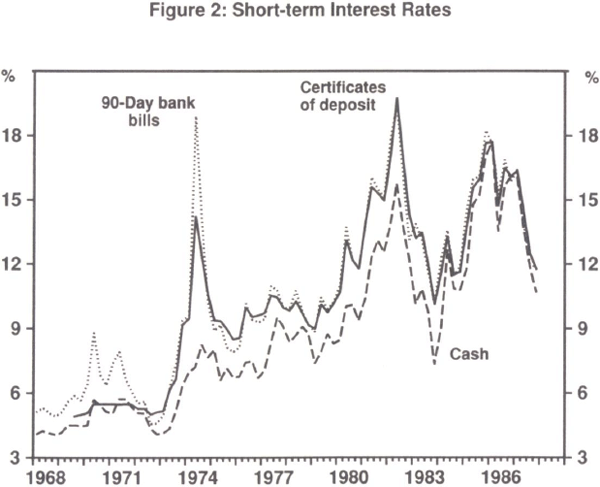
The other very important short-term interest rate for financial intermediaries is the rate on call and overnight funds (the “cash rate”). Unfortunately, this was not representative of short-term interest rates in general in the early part of the period because banks were excluded from this part of the short-term money market until August 1984. The yield on Treasury notes is not used in the study because for much of the period it was not market-determined.
The other issue of importance is whether to use a nominal or a real interest rate. Most of the analysis conducted in this paper uses the nominal rate. One question that might be raised is whether nominal rates are an accurate reflection of the true cost of borrowing in periods such as the mid 1970s, when inflation was high and variable. On the other hand, use of the real rate for analysis and description is complicated by the difficulty of measuring the expected rate of inflation. For the 1980s, when inflation was relatively stable, movements in the real rate were dominated by movements in the nominal rate, so it makes little difference which is used. One simple measure of the real rate of interest is brought into consideration where relevant.[5]
(ii) Banking Aggregates
Three aggregates based mainly on banks' balance sheets are used. They are:
- M1, which is the sum of the public's holdings of currency plus current deposits of trading banks. This is the closest approximation available to the “transactions medium” of traditional monetary theory;
- M3, which is the sum of the public's holdings of currency plus all deposits with banks (trading and savings banks). This series was the focus of monetary policy between 1976 and 1984, when conditional projections were announced at Budget time; and
- bank lending to the public, which is banks' loans, advances and bills discounted.
Both M3 and bank lending are approximately adjusted for the effects of transfers of deposits and loans when major non-bank financial intermediaries became banks, and the effects of foreign bank entry. This removes distortions created by changes in policy relating to bank entry.[6] Effects not caused by such policy changes – for example the winning of business from non-banks by banks – will still be reflected in the data. M1 has not been so adjusted, but this is of little empirical significance since all of the large new banks were savings banks, whose deposits are not included in M1.
(iii) Broader Aggregates
Three aggregates based on the sum of banks' and non-bank financial institutions' balance sheets are used. These series are only available from 1976 when the statistical collections under the Financial Corporations Act started. The three aggregates are:
- broad money, defined as the public's holdings of currency, bank deposits and borrowings from the public by non-bank financial institutions;
- lending by all financial intermediaries (loans, advances and bills discounted), henceforth called “lending”; and
- credit, which is lending plus bank-accepted bills outstanding (other than those discounted by financial intermediaries). Put another way, this is all intermediated lending to the public plus the major form of securitised lending.
Figure 3 assembles the range of financial indicators (levels of interest rates and quarterly growth rates for the aggregates) for the period 1968–87. The bars show growth in nominal demand, with the black part of the bars the portion due to real growth. All financial aggregates and demand have been smoothed using a simple moving average.
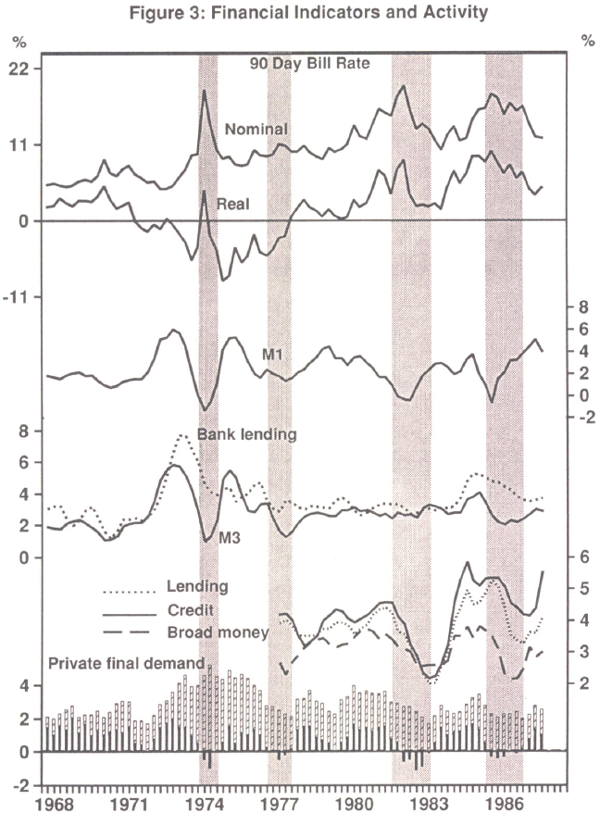
3. Financial Indicators and Real Private Demand: Graphical Comparisons
This section compares each financial indicator in turn with real private demand. In each graph, the bars represent quarterly growth in the smoothed series for real private demand.
(a) Interest Rates
Figure 4 shows the nominal bill rate and movements in real private demand. The relationship is clouded by an upward trend in interest rates for much of the 1970s. This can be attributed to a slow adjustment to the much higher rate of inflation which prevailed during that period than in the 1960s. There was a marked downward trend in real interest rates in the first half of the 1970s, and real rates were only just positive at the end of the 1970s (see Figure 3).
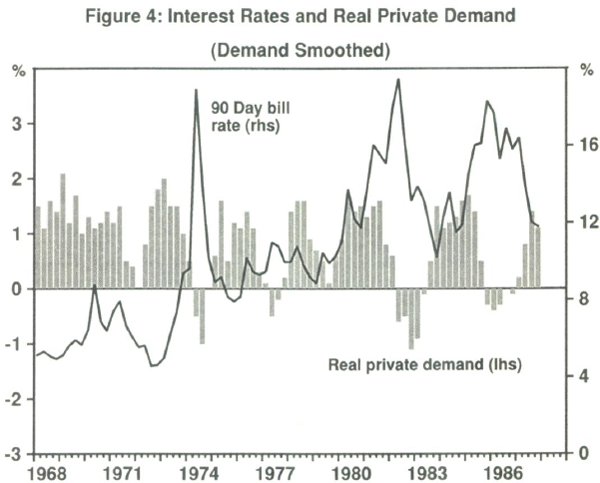
Despite this, there is a clear inverse relationship between nominal interest rates and changes in real private demand. In particular, the three major falls in private demand – 1974/75, 1982/83 and 1985/86 – corresponded to the three major peaks in short-term interest rates. The slowdown of 1977/78 was also accompanied by a rise in the bill rate, but the relationship was weaker. There was also a small peak in the bill rate in 1970 which was not associated with a fall in demand, although there was a slowing in the rate of growth.
Apart from the small rise in 1970, the bill rate did not indicate any “false turning points”. Occasions where the bill rate showed a major rise were always associated with a fall in real private demand and major falls in the bill rate were consistently associated with a rise in demand.
There is also evidence from the graph that interest rates often tended to lead economic activity. This is particularly clear in the 1982/83 and 1985/86 episodes, where interest rates had been rising for some time before demand slowed and eventually fell. The slowdown in 1976/77 was also preceded by a rise in rates, though the relationship was coincident in 1974/75. In all these instances, the bill rate reached its peak in the first quarter that demand fell, and the decline in the bill rate led the pick-up in demand.
(b) Banking Aggregates
Movements in M1 appear to be closely related to movements in real private demand. This is shown in Figure 5. The three sharpest contractions in growth of M1 (where M1 in fact declined in absolute terms) corresponded with the three major falls in demand. Also, there was a slowing in 1977/78, corresponding with the slight fall in demand at that time.
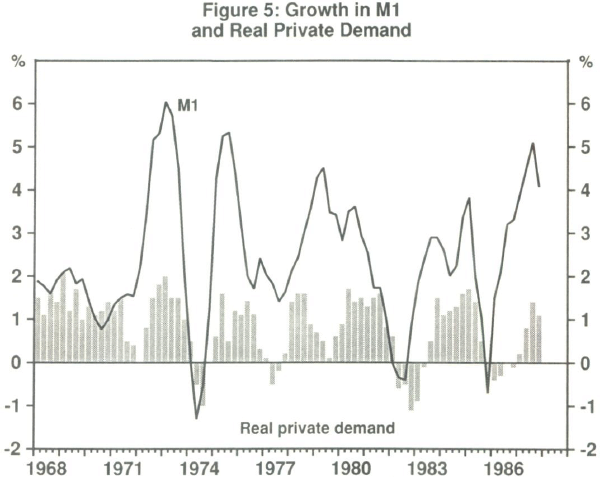
However, M1 does not appear to have performed in its usual manner in the most recent cyclical upturn, where its growth has been exceptionally strong. By 1987, M1 was growing at an annual rate of over 20 per cent, its highest rate since the early 1970s. This was noticeably faster, relative to the growth of real private demand, than in either of the two previous expansions.
Visually, it is difficult to detect whether the bill rate or M1 has the better cyclical relationship with real private demand. The comparison is made more difficult by the fact that the growth of M1 is heavily influenced by movements in interest rates, since the opportunity cost of holding M1 increases with rising interest rates. Holders of bank deposits are able to switch relatively easily between M1 (predominantly non-interest bearing deposits)[7] and the other components of M3 (predominantly interest bearing) in response to changes in interest rates. Figure 6 shows that there is a very strong (negative) association between interest rates and M1. This being so, there is a possibility that movements in M1 do not provide independent information, but are mainly a reflection of already observed movements in interest rates.
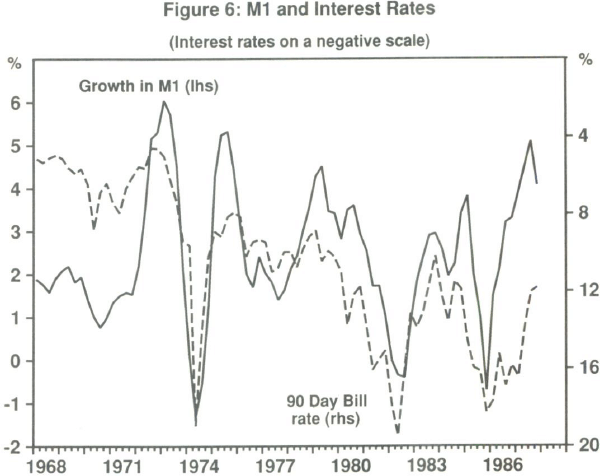
The relationship between M3, bank lending and real private demand is shown in Figure 7. For M3, the relationship seems quite strong for the falls in demand in 1974/75 and 1977/78. There is also a good “fit” for the expansions in the early and mid 1970s.
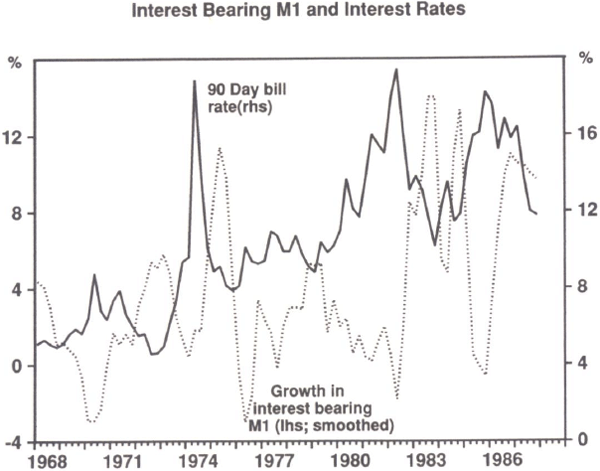
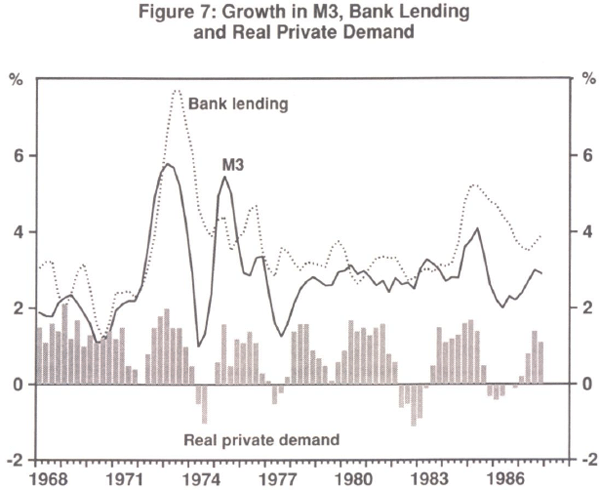
However, the similarity of movement between M3 and real private demand broke down at the end of the 1970s. There was little variation in M3 growth from 1978 to 1983, although demand grew strongly in the early part of the period and fell sharply during the recession of 1982/83. Similarly, there was very little pick-up in M3 growth during the strong expansion in real private demand of 1983 and 1984. More recently, the relationship has looked better. In the slowdown in 1985/86 and the subsequent pick-up, M3 seemed quite good in its relationship to demand, although the lowest growth rate reached was noticeably higher than in the 1974/75 or 1977/78 slowdowns.
From Figure 7 then, it is apparent that a close monitoring of M3 growth over the last decade has been helpful in predicting (or confirming) major movements in economic activity on some occasions, but unhelpful on other occasions. For example, in the most severe post-War recession (1982/83), it was of no help at all.
The dotted line in Figure 7 shows growth in banks' lending to the private sector. It shows a similar pattern to M3 but, if anything, has an inferior “fit”. It correlated well with real private demand over the expansion and contraction phases of the early 1970s but by the mid 1970s, when demand was very weak, bank lending was still growing very quickly. Its relationship to the fall in private demand in 1977/78 was not as close as for M3. It showed the same deficiency as M3 in the 1982/83 episode, and was noticeably less useful than M3 in 1985/86.[8] (In 1986, bank lending was still growing at a faster rate than at virtually any time since the mid 1970s.)
(c) Broader Aggregates
Due to data limitations, there are only two cycles over which it is possible to compare movements in the broader aggregates and demand (Figure 8). However, over this restricted period, it is clear that there is a good correspondence between the cycles in broader aggregates and in real private demand. The two falls in demand and the three expansions were reflected in corresponding movements in each of the three broader aggregates. There is also evidence of a relationship in the more moderate cycle in demand in 1979/80. Over the period since 1976/77 as a whole, the broader aggregates seemed to “fit” the movements in real private demand much more closely than did M3 or bank lending.
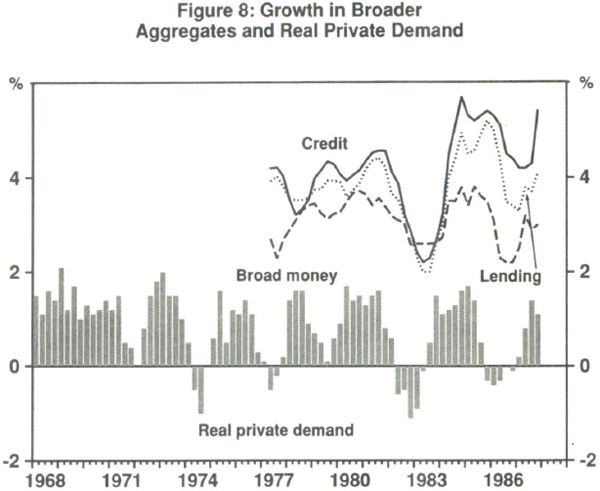
The other feature that stands out from Figure 8 is that the movements in broader aggregates tended to lag movements in real private demand. For example, the trough in the broader aggregates in the 1982/83 downturn was not reached until demand had already fallen for four quarters and was beginning to rise again. The same situation occurred in 1985/86. If anything, lending and credit showed a greater tendency to lag than did broad money. The extreme was during the most recent downturn where credit did not reach its trough until the downturn in private demand had finished and the upswing was well underway.
There is some evidence of a shift in the relationship between lending and credit and demand in recent years. At its low-point in the most recent downturn, growth of credit was still running at an annual rate of about 18 per cent, which was higher than at most points in the previous expansion. The trend increase in use of bill financing, and its rapid expansion over the past three years, accounts for part of this change in relationship. Lending, which only includes loans that are funded on financial intermediaries' balance sheets, also exhibited particularly high growth over the recent cycle. Broad money did not suffer from this deficiency, because some of the growth of lending on intermediaries' balance sheets was funded by liabilities that do not show up in broad money.[9]
4. Financial Indicators and Real Private Demand: Correlation Analysis
This section augments the graphs shown in the previous section by calculating simple correlation coefficients between each financial variable and real private demand. As well as helping to quantify the strength of the relationship between the pairs of variables, it also provides a simple quantitative test of whether a particular variable leads or follows private demand. The section is in two parts. Part (a) gives results for the complete data period; part (b) gives results for selected sub-periods.[10]
(a) Full Sample Results
Table 1 summarises the results of tests to see whether each financial variable has a coincident or leading relationship with real private demand. The first column shows the correlation coefficients between current movements in demand and the current movements in the various financial indicators. The second column shows the correlation between the current movement in private demand and the movement in the financial indicators in the previous period, and so on.
| Indicator | Lead in Quarters2 | |||||
|---|---|---|---|---|---|---|
| 0 | 1 | 2 | 3 | 4 | 5 | |
| Bill rate | −.37** | −.40** | −.39** | −.29** | −.25** | −.18 |
| M1 | .31** | .32** | .27** | .11 | .05 | −.04 |
| M3 | .26** | .17 | −.01 | −.15 | −.22* | −.05 |
| Bank lending | .09 | −.04 | −.15 | −.28** | −.39** | −.24** |
| Broad money1 | .37** | .14 | .23 | .09 | −.02 | .13 |
| Lending1 | .09 | .14 | .11 | .08 | .04 | −.05 |
| Credit1 | .05 | .15 | .11 | .08 | .06 | −.05 |
| 1. The estimation period for these variables is from 1976–87.
The others are for the full period of 1968–87. All financial
aggregates and demand are in percentage change form, seasonally
adjusted. 2. An asterisk indicates significance at the 10 per cent level; two indicate the 5 per cent level. |
||||||
The top row of Table 1 shows that the first five correlation coefficients between interest rates and domestic demand are all significant and of the expected (negative) sign. Not only are the current quarter's interest rates correlated with current private demand, but interest rates as long ago as a year are correlated with private demand. Expressed in a different way, a change in interest rates is associated with changes in private demand in the same quarter, and over the next year.
M1 also has a significant relationship to private demand, with M1 in the current quarter, and in the previous two quarters, positively correlated with demand. This establishes a clear leading relationship for M1, consistent with the graphical evidence. On balance, the relationship is not as strong for M1 as it is for interest rates. The correlation coefficients are a little smaller, and the lead time between movements in M1 and movements in private demand is shorter than for interest rates.
The results for M3 are noticeably weaker. The only significant coefficient of the correct (positive) sign is the coincident one, and its value is lower than for either M1 or interest rates. There is a significant coefficient on the fourth lead, but it is of the wrong sign. Bank lending is less satisfactory than M3, as there are no significant correlations of the correct sign (although there is a sequence with the wrong sign at leads from three to five quarters).
Among the broader aggregates, the results are also weak; the only significant coefficient is a coincident one between broad money and private demand. Neither lending nor credit show a coincident correlation at all.
An obvious explanation is that the broader aggregates do not lead demand, but lag it. Table 2, which contains correlation coefficients between lags of real private demand and current movements in the broad aggregates, confirms this. Most of these coefficients are significant and positive, i.e. movements in private demand occur before the associated movement in the financial aggregates. The strongest results are for lending. This supports the visual evidence that broad financial aggregates have a strong pro-cyclical behaviour, but lag the cycle in private demand.
| Indicator | Lag in quarters2 | |||||
|---|---|---|---|---|---|---|
| 1 | 2 | 3 | 4 | 5 | ||
| Bill rate | −.25** | −.13 | −.05 | .00 | .06 | |
| M1 | .21* | −.16 | −.24** | −.31** | −.36** | |
| M3 | .24** | .04 | −.24** | −.19* | −.22* | |
| Bank lending | .07 | .10 | .03 | .07 | .04 | |
| Broad money1 | .43** | .36** | .39** | .26* | −.19 | |
| Lending1 | .30* | 44** | .51** | .49** | .24 | |
| Credit1 | .25* | .38** | .45** | .46** | .19 | |
| 1. The estimation period for these variables is from 1976–87.
The others are for the full period of 1968–87. All financial
aggregates and demand are in percentage change form, seasonally
adjusted. 2. An asterisk indicates significance at the 10 per cent level; two indicate the 5 per cent level. |
||||||
(b) Variation Between Sub-Periods
The period over which these relationships have been tested contains major structural changes in the financial system; it has moved from being heavily regulated to being largely deregulated. This change occurred in a number of steps over the period; a full account of the various changes is contained in a later paper in this volume.[11]
Any division of the two-decade period into regulated and deregulated sub-periods will inevitably be partly arbitrary. For the present purposes, the major division has been made at December 1980. This was when all interest rate controls on bank deposits were removed. The period from 1968 to 1980 is regarded as being predominantly regulated and the period from 1980 to 1987 as predominantly deregulated. Within the latter period, the sub-period December 1983 to December 1987 corresponds to a further step in deregulation when the Australian dollar was floated, maturity restrictions on bank deposits were removed (in 1984) and open market operations became the main technique for implementation of monetary policy.
Table 3 shows correlation coefficients for those sub-periods. Like Table 1, it tests only for coincident and leading relationships between financial variables and real private demand.
| Indicator | Sub-periods1 | |||
|---|---|---|---|---|
| Lead in Quarters |
Mar. 1968 to Dec. 1980 |
Dec. 1980 to Dec. 1987 |
Dec. 1983 to Dec. 1987 |
|
| Bill rate | 0 | −.37** | −.37** | −.76** |
| 1 | −.36** | −.54** | −.76** | |
| 2 | −.33** | −.56** | −.61** | |
| 3 | −.10 | −.60** | −.50** | |
| 4 | −.08 | −.47** | −.35 | |
| 5 | .00 | −.29 | −.27 | |
| M1 | 0 | .30** | .30 | .34 |
| 1 | .24* | .45** | .48* | |
| 2 | .12 | .52** | .36 | |
| 3 | .01 | .24 | −.11 | |
| 4 | −.13 | .31 | .24 | |
| 5 | −.15 | .10 | .13 | |
| M3 | 0 | .24* | .37* | .62** |
| 1 | .21 | .08 | .15 | |
| 2 | −.05 | .18 | −.04 | |
| 3 | −.17 | −.10 | −.22 | |
| 4 | −.26* | −.14 | −.30 | |
| 5 | −.07 | −.06 | −.25 | |
| Bank lending | 0 | .09 | .17 | .02 |
| 1 | −.04 | −.05 | −.30 | |
| 2 | −.18 | −.09 | −.56** | |
| 3 | −.26** | −.39** | −.80** | |
| 4 | −.41** | −.40** | −.70** | |
| 5 | −.26* | −.22 | −.56** | |
| Broad money | 0 | – | .40** | .48* |
| 1 | – | .13 | −.02 | |
| 2 | – | .08 | .10 | |
| 3 | – | −.13 | −.25 | |
| 4 | – | −.36* | −.62** | |
| 5 | – | −.32* | −.48* | |
| Lending | 0 | – | .16 | −.11 |
| 1 | – | .07 | −.22 | |
| 2 | – | −.11 | −.30 | |
| 3 | – | −.36* | −.56** | |
| 4 | – | −.43** | −.63** | |
| 5 | – | −.52** | −.69** | |
| Credit | 0 | – | .17 | −.19 |
| 1 | – | .13 | −.11 | |
| 2 | – | −.07 | −.23 | |
| 3 | – | −.31 | −.51** | |
| 4 | – | −.38** | −.54** | |
| 5 | – | −.53** | −.72** | |
| 1. An asterisk indicates significance at the 10 per cent level; two indicate the 5 per cent level. | ||||
The top panel shows results for the relationship between interest rates and real private demand. In all three sub-periods, there is a significant coincident and leading relationship with private demand. The strength of this relationship (indicated by the size of the correlation coefficients) increases in the more recent sub-periods. The correlations between real private demand and interest rates at leads from one to four quarters are the strongest identified in the various tests in this paper.[12]
The second panel shows results for the relationship between M1 and real private demand. Overall, the relationship is not as strong as that between interest rates and demand. It looks marginally stronger in the post-1980 period, with larger coefficients and slightly improved significance levels. It then seems to deteriorate post-1983, with coefficients noticeably less significant. This is consistent with the discussion of the graphical evidence that suggested some recent shift in the relationship between M1 and demand.
Somewhat surprisingly in view of the visual evidence, the correlation coefficients for M3 suggest that there has been no deterioration in its relationship with real private demand. The correlation is not as strong as for interest rates or M1 in the early period, and it has no leading characteristics, but it has not deteriorated on the basis of evidence in Table 3. In fact, the results suggest that the contemporaneous correlation has strengthened over the most recent period.
But it is clear from the graph that shifts in the relationship between M3 and activity have occurred within our sub-samples, notably in 1982/83, and possibly also in 1985. A more detailed breakdown of the periods for the correlations suggests that M3 had a very strong leading relationship with demand between 1970 and 1977 (a significant correlation coefficient of 0.44). Between 1977 and 1983, this relationship disappeared, with no concurrent or leading coefficients being significant. After 1983, a strong concurrent relationship (evident in Table 3) is found. These results are consistent with views put forward elsewhere that the relationship between M3 and activity has at times been unstable over the past 20 years.
Broad money shows a strong coincident relationship with real demand through both of the sub-periods. There is no evidence of broad money playing a leading role. There is also no evidence of coincident relationships for the broader lending aggregates in the sub-period analysis. Several leading coefficients are significant in these cases, but with unexpected signs (negative). This strengthens in the 1983–1987 period. One explanation for this apparently paradoxical result could lie in the number of turning points in the 1980s. If these aggregates in fact lag activity (as the evidence in Table 2 suggests), then negative correlations between leads of the aggregates and current demand might be expected where there are pronounced cycles in demand. In effect, these coefficients are picking up the fact that just after a turning point, demand is negatively correlated with lags of itself.
In summary, the evidence to this point suggests that nominal interest rates and M1 have had a consistent, leading relationship with real private demand over the past 20 years. Other bank-based aggregates have been less consistent as indicators. Broader aggregates have had reasonably good relationships, but have tended to be lagging or coincident indicators.
5. Financial Indicators and Nominal Private Demand: Graphical Comparisons
It might be objected, with respect to Sections 3 and 4, that financial aggregates measured in nominal terms should not really be compared with real magnitudes for activity. Traditional notions of the demand for money, for example, typically explain the demand for real money balances in terms of real income and the opportunity cost of holding money. Alternatively, the real quantity of credit extended by intermediaries might be a determinant of real expenditure. Under this sort of framework, nominal financial variables should be compared with nominal measures of activity. This approach is taken in this and the following section.
Part (a) of this section looks at a nominal series for private demand and compares it with the real series used in Sections 3 and 4. Part (b) looks at the relationship between interest rates and nominal demand, while Part (c) examines the banking aggregates. The final part compares nominal demand with the broader financial aggregates.
(a) Growth in Nominal Demand
Figure 9 compares (smoothed) growth in nominal and real private demand over the period 1968–1987. Several features stand out.
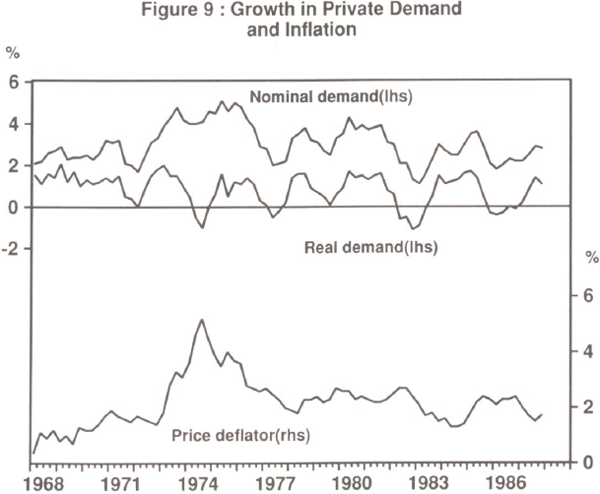
Firstly, for much of the period under consideration, the rate of inflation is considerably less volatile than the rate of growth of real demand. As a result, the nominal and real series for demand exhibit similar patterns. The major exception was during 1974 when real private demand fell quite sharply. With inflation rising, growth in nominal private demand fell only slightly, after the fall in real growth, and recovered before real growth became positive again.
In each of the four “recessions” identified using growth in real private demand, growth in nominal demand also fell, on three occasions quite noticeably, though nominal demand never actually fell in absolute terms.
Most turning points of nominal demand were coincident with or lagged those of real demand. The exception was during the mid 1970s when nominal demand turned prior to real demand in two instances.
(b) Interest Rates
Figure 10 shows the bill rate, in both nominal and real terms,[13] and growth in nominal private demand. In the second half of the period, the relationship between the nominal bill rate and nominal demand was similar to that found for real demand: rises in interest rates preceded falls in the growth of demand, and falls in interest rates preceded pick-ups in demand.
The relationship is more complex in the first half of the graph. It is clear that nominal interest rates did not perform well as an indicator of nominal demand in this period. Up to 1971, the general upward trend in growth of nominal demand was matched by a rise in nominal interest rates. The major acceleration in demand in 1972–73 was preceded by a slight fall in interest rates, but was followed by a very large rise in nominal interest rates. The subsequent slowing in nominal demand was much more subdued, relative to the size of the rise in nominal interest rates, than the slowing in real demand. At about the same time as nominal interest rates came down very quickly in the second half of 1974, growth in nominal demand rose again, to annual rates of around 20 per cent in 1975.
downturn in growth of nominal demand, and demand subsequently picked up only slightly when M3 growth increased rapidly. In the following episode, by contrast, M3 and demand growth were much more closely related.
As was the case for real demand, there was not much of a relationship between M3 and nominal demand from 1976 to 1983. M3 showed no indication of the downturn in nominal demand in 1982/83. A fairly close relationship between M3 and nominal demand was re-established in the most recent cycle, but it was coincident rather than leading.
Bank lending, like M3, had a strong cyclical relationship to nominal demand in the 1973–74 period, but its performance seems to have worsened after that. A stronger relationship was re-established from about 1985, although the most recent upturn in nominal demand appeared to lead the upturn in bank lending by around four quarters. Further, a shift in the relationship is apparent: the trough in the growth of bank lending was much higher than the average growth of bank lending at any time since the mid 1970s, despite a sizeable fall in nominal demand growth in 1985.
(d) Broader Aggregates
Figure 13 shows growth in nominal demand and growth in the broader financial aggregates – broad money, lending and credit. All three aggregates have a strong positive relationship with growth in nominal demand, although they appear to lag it.
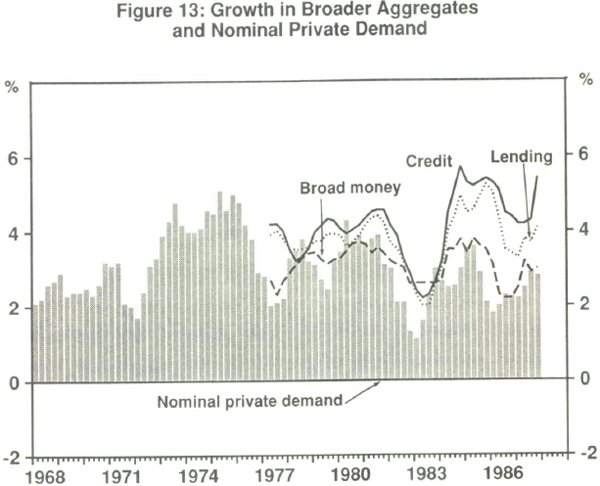
Broad money had a good association with both major downturns in nominal demand. It also had a clear positive relationship with the smaller downturn in 1979. In most cases, turning points in broad money tended to lag those in nominal demand. There were a few cases which were arguably coincident. Credit and lending also exhibited a positive relationship with nominal demand, although they appeared to lag nominal demand by more than broad money.
While all three aggregates grew at rates a little above that of nominal demand in the late 1970s and early 1980s, lending and credit have grown at rates considerably higher than demand since 1985. This suggests some structural change in the relationship between activity and lending and credit.
6. Financial Indicators and Nominal Private Demand: Correlation Analysis
This section presents correlation coefficients between financial indicators and nominal private demand. It follows the same format as Section 4: Part (a) shows results for the full 1968–87 period, while Part (b) separates the data into sub-periods.
(a) Full Sample Results
Table 4 presents correlation coefficients between the range of financial variables and nominal private demand. Results out to a lead of six quarters are reported. This is one quarter more than for real demand because significant coefficients were found at longer leads.
| Indicator | Lead in Quarters2 | ||||||
|---|---|---|---|---|---|---|---|
| 0 | 1 | 2 | 3 | 4 | 5 | 6 | |
| Bill rate | −.02 | −.10 | −.18 | −.23** | −.26** | −.28** | −.30** |
| M1 | .02 | .19* | .34** | .39** | .39** | .32** | .26** |
| M3 | .22* | .39** | .43** | .40** | .34** | .29** | .22** |
| Bank lending | .34** | .41** | .41** | .40** | .33** | .30** | .29** |
| Broad money1 | .55** | .33** | .29* | .15 | .09 | .09 | −.01 |
| Lending1 | .46** | .22 | .12 | .06 | .08 | .03 | .03 |
| Credit1 | .34** | .16 | .07 | .04 | .07 | .02 | −.06 |
| 1. The estimation period for these variables is from 1976–87.
The others are for the full sample, 1968–87. All financial aggregates
and demand are quarterly percentage changes. 2. An asterisk indicates significance at the 10 per cent level; two indicate the 5 per cent level. |
|||||||
For interest rates, all significant coefficients are negative, as expected. In other words, a rise in the short-term interest rate is generally associated with a fall in nominal demand, a result consistent with those found using real demand. The important difference is that there is no coincident relationship, and no relationship at leads 1 and 2, and that the coefficients at leads 5 and 6 are now significant. That is, the lead length is extended by 2–3 quarters compared with the results for real demand. The picture is similar for M1. There are strong positive correlations with nominal demand, beginning at the second lead, and continuing to the sixth lead.
For M3 and bank lending, the results are much stronger than they are for real demand. They also show larger coefficients on M3 as compared with interest rates and M1. There are large and significant positive coefficients running from zero to six quarter leads for both M3 and bank lending.
Broad money has a significant positive correlation with nominal demand, which is the strongest in the current quarter and extends to lead 2. This significant leading role for broad money contrasts with its relationship to real demand, where the only significant positive correlation was the coincident one.
Lending and credit have very similar correlation patterns. The current coefficients are both positive and significant (unlike the results using real demand), but no leading coefficients are significant. Table 5 shows correlations between the financial indicators and nominal demand when the financial indicators are allowed to lag demand. It suggests that the broader lending and credit aggregates do lag nominal demand.
| Indicator | Lag in quarters2 | |||||
|---|---|---|---|---|---|---|
| 1 | 2 | 3 | 4 | 5 | ||
| Bill rate | .05 | .10 | .11 | .10 | .06 | |
| M1 | −.13 | −.23** | −.23** | −.21* | −.16 | |
| M3 | .09 | −.03 | −.11 | −.09 | −.08 | |
| Bank lending | .24** | .15 | .03 | −.04 | −.13 | |
| Broad money1 | .44** | .17 | −.02 | −.18 | −.30** | |
| Lending1 | .51** | .40** | .19 | −.05 | −.26* | |
| Credit1 | .40** | .32** | .12 | −.12 | −.34** | |
| 1. The estimation period for these variables is from 1976–87.
The others are for the full sample, 1968–87. All financial aggregates
and demand are quarterly percentage changes. 2. An asterisk indicates significance at the 10 per cent level; two indicate the 5 per cent level. |
||||||
In comparing the correlation results above to those for real demand, it appears that the lead time is longer for those variables which lead demand and that the lag time is shorter for those which lag demand.
(b) Variation Between Sub-Periods
Table 6 presents the sub-sample correlation coefficients for the financial indicators and nominal private demand. In the first sub-period, interest rates have a strong positive relationship with nominal demand, both coincidentally and over the six leading quarters. These results are in stark contrast to the full sample (and to the results for real demand). But they are consistent with the graphical evidence, which showed an apparent positive association of interest rates with nominal demand during the early 1970s. It is likely that the strength of this association, given the very large movements in both the series, dominates the correlation result.
| Indicator | Sub-periods1 | |||||
|---|---|---|---|---|---|---|
| Lead in Quarters |
Mar. 1968 to Dec. 1980 |
Dec. 1980 to Dec. 1987 |
Dec. 1983 to Dec. 1987 |
|||
| Bill rate | 0 | .39** | .41** | .12 | ||
| 1 | .36** | .06 | −.16 | |||
| 2 | .31** | −.28 | −.51** | |||
| 3 | .32** | −.53** | −.71** | |||
| 4 | .32** | −.69** | −.70** | |||
| 5 | .33** | −.75** | −.63** | |||
| 6 | .31** | −.70** | −.54** | |||
| M1 | 0 | .14 | −.37* | −.49* | ||
| 1 | .24* | −.01 | −.08 | |||
| 2 | .30** | .37** | .38 | |||
| 3 | .33** | .45** | .37 | |||
| 4 | .29** | .55** | .25 | |||
| 5 | .24 | .46** | .12 | |||
| 6 | .19 | .34* | −.01 | |||
| M3 | 0 | .30** | .00 | .36 | ||
| 1 | .47** | .18 | .74** | |||
| 2 | .50** | .32* | .71** | |||
| 3 | .49** | .19 | .33 | |||
| 4 | .45** | .08 | −.00 | |||
| 5 | .38** | .09 | −.20 | |||
| 6 | .34** | −.12 | −.38 | |||
| Bank lending | 0 | .43** | .17 | .37 | ||
| 1 | .54** | .14 | .36 | |||
| 2 | .55** | .08 | .24 | |||
| 3 | .57** | −.11 | −.12 | |||
| 4 | .52** | −.25 | −.49* | |||
| 5 | .49** | −.26 | −.62** | |||
| 6 | .49** | −.31 | −.72** | |||
| Broad money | 0 | – | .52** | .64** | ||
| 1 | – | .52** | .48* | |||
| 2 | – | .51** | .38 | |||
| 3 | – | .33* | .25 | |||
| 4 | – | .23 | .08 | |||
| 5 | – | .09 | −.11 | |||
| 6 | – | −.20 | −.48* | |||
| Lending | 0 | – | .59** | .49* | ||
| 1 | – | .52** | .23 | |||
| 2 | – | .35** | .05 | |||
| 3 | – | .13 | −.08 | |||
| 4 | – | .03 | −.15 | |||
| 5 | – | −.13 | −.33 | |||
| 6 | – | −.26 | −.54** | |||
| Credit | 0 | – | .48** | .25 | ||
| 1 | – | .45** | .15 | |||
| 2 | – | .34* | .08 | |||
| 3 | – | .18 | .03 | |||
| 4 | – | .06 | −.04 | |||
| 5 | – | −.16 | −.29 | |||
| 6 | – | −.30 | −.59** | |||
| 1. An asterisk indicates significance at the 10 per cent level; two indicate the 5 per cent level. | ||||||
This is confirmed by results for the 1980–87 period. In this latter period, only the coincident coefficient remains positive and significant, while the coefficients from leads 3 to 6 are negative. In the 1983–87 period, coefficients for leads 2 to 6 are negative and significant, and the coincident coefficient is insignificantly different from zero. This latter relationship is sufficiently strong to dominate the correlation results for the full sample period.[15]
The results for M1 also show noticeable changes in coefficients. The expected positive relationship between M1 and nominal demand is evident in the 1968–1980 sample for leads 1 to 4. The lag structure for the positive relationship lengthens in the 1980–87 period, and the coincident coefficient becomes negative. But in the 1983–87 period, the only significant relationship is a coincident, and negative one.[16]
For M3 and bank lending the strong, positive and leading relationship observed in the full sample is shown to be largely a reflection of the 1968–80 sub-period.[17] In the 1980–87 period, none of the coefficients were significant. The coincident and first two leading coefficients became significant in the 1983–87 period for M3, but for bank lending the only significant coefficients were of the wrong (negative) sign.
Broad money, lending and credit showed a leading relationship in the 1980–87 period, with the coincident and first two or three leading coefficients positive and significant in each case. But this was largely a result of the pre-December 1983 period, and the relationship deteriorated in the 1983–87 period. Each indicator lost a couple of significant leading coefficients, and credit did not have any significant positive coefficients at all. Each of the broad aggregates has a significant coefficient of the wrong (negative) sign at lead 6.
7. Conclusions
The evidence in this paper suggests that big changes in financial conditions are associated with big changes in private demand. This conclusion holds whether demand is measured in nominal or real terms.
The most useful financial indicators, in the sense of having a consistent, leading relationship to real private demand, are short-term interest rates and M1 (though these do not seem to be completely independent). The process of deregulation does not appear to have weakened the relationship between interest rates and real demand; if anything, that relationship has strengthened over recent years. For M1, however, there may have been some shift in the relationship recently.
The other banking aggregates were useful as leading indicators of real demand in the mid 1970s, but have been less useful since; they were particularly poor indicators in the early 1980s. Broader aggregates have a good relationship with real private demand, but their usefulness is confined to confirming what the indicators from the real economy have already suggested. There is also evidence of a shift in the relationship of broad lending and credit aggregates to real demand in recent years.
Nominal interest rates have been less useful as an indicator of growth in nominal private demand during periods of high and variable inflation, such as in the early and mid 1970s. (Since 1983, the relationship of nominal interest rates to nominal demand has improved noticeably.) The banking aggregates generally performed much better than nominal interest rates as indicators of nominal demand in such periods. This suggests care in the use of interest rates as indicators. When inflation is changing noticeably, some measure of the real cost of borrowing (even though necessarily crude) will be an important additional indicator.
It is also possible that the usefulness of the banking aggregates, relative to interest rates, as indicators of nominal demand in these earlier periods may have been a function of the regulatory environment. This question has not been addressed in this paper; it is taken up in the paper by Battellino and McMillan in this volume. But there is evidence that these aggregates have failed as indicators at crucial times in the 1980s.
Broader aggregates are also closely related to nominal demand; there is less of a lag here (and in some cases, a leading relationship) than in the relationship to real demand. There is, however, evidence of a shift in the relationship since deregulation. The broad lending and credit aggregates have been growing much faster than nominal demand in recent years, and there is now no evidence that they lead nominal demand.
In comparing the results obtained from the real and nominal activity indicators, there is also an implication that movements in real demand tend to precede movements in inflation. This would help to explain, for example, the lengthening of the leading relationships (between many of the financial variables and demand) when the nominal demand results are compared with the real demand results.
While the paper has not sought to discuss relationships in terms of causality, the data, particularly for the deregulated period, do suggest a certain temporal ordering. Since deregulation, that ordering can be characterised as follows: interest rates move first, followed by M1. Real private demand moves immediately and for the next year.. Nominal demand moves a little later. Other financial aggregates tend to move with, or a little later than, real private demand and coincidently with nominal demand.
Any description of the monetary “transmission mechanism” must be consistent with that ordering. This is a topic for a future paper.
Appendix
The following sections detail sources of the data and, where appropriate, methods used to adjust the data.
1. Activity Variables
The activity variables used in the paper are from the December 1987 issue of the Quarterly Estimates of National Income and Expenditure, ABS Cat. No. 5206.0. Private demand is the sum of private consumption, dwelling investment (including real estate transfer expenses) and business fixed investment. Data for nominal demand are seasonally adjusted, at current prices; those for real demand are seasonally adjusted, in constant 1979/80 prices. Constant price data for periods prior to the March quarter 1969 are spliced from the 1974/75 based series.
Smoothing
The smoothed series for activity variables are, in all cases, three-quarter moving averages, centred on the reference quarter. For example, the smoothed figure for demand as at June 1987 is an average of the observations for the March, June and September quarters. Quarterly percentage changes in this smoothed series are shown on the graphs.
The intention of this process is to enable trends to be seen more easily on the graphs by smoothing out large fluctuations from quarter to quarter. At the same time, it is desirable to avoid giving a misleading impression as to the timing of turning points, hence, the moving average is centred, and has a small number of terms. For the correlation coefficients, unsmoothed (but still seasonally adjusted) data are used.
2. Financial Variables
(a) Interest Rates
Data for the yield on 90-day bank-accepted bills are from the Reserve Bank Bulletin; historical series are available on the Bulletin Database. The monthly data are averaged for each quarter, to form a better representation of the average interest rate prevailing in the quarter. Data for real interest rates are calculated by deducting the year-ended change in the Consumer Price Index from the nominal bill rate.
Data on the cash rate and the rate on certificates of deposit are also obtained from the Reserve Bank Bulletin and Bulletin Database. As for the 90-day bill rate, quarterly data are the average of monthly figures.
(b) Financial Aggregates
For the monetary and credit aggregates, all data are from the Reserve Bank Bulletin. Data for M1 and M3 are seasonally adjusted, as calculated by the Australian Bureau of Statistics. Data for broad money, bank lending, lending by all financial intermediaries and credit have been seasonally adjusted by the authors, using the multiplicative X-11Q procedure. In each case, a standard F-test could reject the null hypothesis of no stable seasonality.
The quarterly figures are the average of the (seasonally adjusted) monthly figures. Quarterly growth rates for M3 and bank lending are adjusted for the entry of new banks. Those banks whose statistics were not available for each of the six monthly figures needed to calculate the percentage change between quarters were excluded for the purposes of the calculation.
For growth in M1, the smoothed series is calculated in the same way as smoothed growth in private demand is calculated. The smoothed series for the other aggregates are three-term centred moving averages of the quarterly growth rates. (The averages of the growth rates are used because breaks in the levels series complicate calculations based on averaging the levels first.)
3. Correlation Coefficients
The sample correlation coefficients reported in the text have been calculated using the CORR procedure in version 5 of SAS.[1] The sample correlation estimates the true correlation between two variables, x and y, and is calculated as:
where  and
and  are the sample means of x and
y.
are the sample means of x and
y.
The significance probability of the sample correlation coefficient is calculated by treating
as coming from a t distribution with n−2 degrees of freedom, where n is the sample size.
The correlation coefficients in the paper are calculated using seasonally adjusted data for financial aggregates. Where these have been seasonally adjusted by the authors, the correlations based on the original data (but still adjusted for new banks) are shown in Tables A1 and A2.
| Indicator | Lead in quarters2 | |||||
|---|---|---|---|---|---|---|
| 0 | 1 | 2 | 3 | 4 | 5 | |
| Bank lending1 | .09 | −.07 | −.09 | −.19 | −.24 | −.24 |
| Broad money | .06 | −.04 | .25* | −.04 | −.01 | .03 |
| Lending | .07 | −.19 | −.12 | .04 | −.02 | −.01 |
| Credit | .11 | .11 | .05 | .11 | .11 | −.05 |
| 1. Correlations over 1968–87. The correlations
for other variables are over the period 1976–1987. 2. An asterisk indicates significance at the 10 per cent level; two indicate the 5 per cent level. |
||||||
| Indicator | Sub-periods1 | |||
|---|---|---|---|---|
| Lead in Quarters |
Mar. 1968 to Dec. 1980 |
Dec. 1980 to Dec. 1987 |
Dec. 1983 to Dec. 1987 |
|
| Bank lending | 0 | .00 | .21 | .08 |
| 1 | .01 | −.06 | −.21 | |
| 2 | −.19 | −.11 | −.61** | |
| 3 | −.12 | −.39** | −.72** | |
| 4 | −.35** | −.25 | −.57** | |
| 5 | −.19 | −.19 | −.44* | |
| Broad money | 0 | – | .13 | .36 |
| 1 | – | −.16 | −.11 | |
| 2 | – | .12 | .06 | |
| 3 | – | −.16 | −.12 | |
| 4 | – | −.02 | −.40 | |
| 5 | – | −.24 | −.38 | |
| Lending | 0 | – | .17 | .08 |
| 1 | – | .02 | −.24 | |
| 2 | – | −.16 | −.50** | |
| 3 | – | −.32* | −.48* | |
| 4 | – | −.25 | −.37 | |
| 5 | – | −.48* | −.61** | |
| Credit | 0 | – | .22 | −.02 |
| 1 | – | .06 | −.23 | |
| 2 | – | −.11 | −.38 | |
| 3 | – | −.26 | −.33 | |
| 4 | – | −.23 | −.35 | |
| 5 | – | −.48** | −.69** | |
| 1. An asterisk indicates significance at the 10 per cent level; two indicate the 5 per cent level. | ||||
Footnote Appendix
The source of the following is SAS Users Guide: Basics, Version 5 Edition (1985) Cary NC: SAS Institute Inc. [1]
Footnotes
Recent Reserve Bank work examining the stability of the demand for money includes Stevens, Thorp and Anderson (1987), and Blundell-Wignall and Thorp (1987). Recent work on the timing of the relationships between financial aggregates and economic activity has used vector-auto-regression techniques, such as in Bullock, Stevens and Thorp (1988). A generation of large-scale econometric models developed in the Bank gave an important and direct role to money in the determination of spending. The structure of the RBA82 version of the model is set out in Fahrer, Rankin and Taylor (1984). More recent development work is detailed in Edey, Kerrison and Menzies (1987). [1]
See for example Davis and Lewis (1977), Sharpe (1975), Beck, Bush and Hayes (1973), Boehm and Defris (1977) and Boehm (1987). [2]
The series is smoothed by taking a three-quarter, centred moving average. See the Appendix for more details. [3]
All the empirical work has also been done using GDP as a reference cycle. There are some differences in the results, reflecting the above factors. The more substantive of these are noted in the text or in footnotes at the relevant point. [4]
It is defined as the nominal interest rate less the four-quarter ended change in the consumer price index for the same quarter. [5]
Details of the procedure used are given in the Appendix. [6]
Removal of bank interest rate and maturity controls has raised the share of interest bearing deposits in M1 in recent years, to around 20 per cent by end 1987. But, as the graph below shows, even the interest-bearing component appears to be sensitive to market interest rates. [7]
There was a considerable divergence between growth of M3 and bank lending in 1985 and 1986, with lending growing much more quickly. In earlier periods, such as the mid 1970s, such differences were due to changes in holdings of LGS assets by banks. This was not the explanation in 1985/1986. The rapid growth of lending was financed in part by liabilities other than conventional $A deposits. In particular, new foreign banks funded part of their lending with capital, and banks (particularly the new ones) also increasingly used foreign currency borrowings (not included in M3). Declines in holdings of local and semi-government securities by savings banks (associated with changes in Prescribed Assets Ratio regulations) were also a factor. In other words, bank lending would appear to be a better indicator of movements in banks' balance sheets than M3 over this period. [8]
Broad money was affected by the same factors which hold growth of M3 below bank lending, namely the rapid growth of non-A$ and non-deposit liabilities. Borrowing from parent companies offshore by NBFIs was also a factor. [9]
The formula for the correlation coefficient is given in the appendix, along with notation on how significance levels are calculated. [10]
Battellino and McMillan, “Changes in the Behaviour of Financial Institutions and Their Implications for Financial Aggregates”, this volume, pp 124–146. [11]
It should be noted that the results for the last sub-period are not as strong when real GDP is used as the indicator of activity rather than private demand. [12]
The real bill rate is defined in footnote 5. [13]
The negative leading relationship between interest rates and nominal GDP in the post-1983 period is not as strong. [15]
Here again the results are sensitive to the choice of indicator for activity. The use of nominal GDP provides a significant positive relationship at the first quarter lead for M1. [16]
More detailed analysis (not reported here) suggests that the long leading relationship in the full sample is largely determined by the data in the late 1960s and early 1970s. [17]
References
Beck, M.T., Bush, M.G. and Hayes, R.W. (1973), “The Indicator Approach to the Identification of Business Cycles”, Reserve Bank of Australia Occasional Paper No. 2, June.
Blundell-Wignall, A. and Thorp, S. (1987), “Money Demand, Own Interest Rates and Deregulation”, Reserve Bank of Australia Research Discussion Paper No. 8703, May.
Boehm, E.A. (1987), “New Economic Indicators for Australia: A Further Report”, IAESR Working Paper No. 4, April.
Boehm, E.A. and Defris, L.V. (1977), “Recurring Periods of Plateau Slumps and Sluggish Recoveries in the Australian Economy: 1950 to 1976”, Australian Economic Review, 1st Quarter, pp 53–60.
Bullock, M., Stevens, G. and Thorp, S. (1988), “Do Financial Aggregates Lead Activity? A Preliminary Analysis”, Reserve Bank of Australia Research Discussion Paper No. 8803, January.
Davis, K. and Lewis, M. (1977), “Money and Income: Evidence from Simple Models”, in The Australian Monetary System in the 1970s, Porter, M.G. and Burns, M.E. (eds.), Monash University, Melbourne.
Edey, M.L., Kerrison, E.J. and Menzies, G.D. (1987), “Transmission of External Shocks in the RBII Model”, Reserve Bank of Australia Research Discussion Paper No. 8710, November.
Fahrer, J.G., Rankin, R.W. and Taylor, J.C. (1984), “The Equations of the RBA82 Model of the Australian Economy”, Reserve Bank of Australia Research Discussion Paper No. 8401, August.
Goodhart, C.A.E. (1975), “Problems of Monetary Management: The U.K. Experience”, Papers in Monetary Economics, Reserve Bank of Australia, Sydney.
Sharpe, I.G. (1975), “The Money Supply, Financing Government and Economic Activity”, Economic Papers, No. 50, December, pp 23–43.
Stevens, G., Thorp, S. and Anderson, J. (1987), “The Australian Demand Function for Money: Another Look at Stability”, Reserve Bank of Australia Research Discussion Paper No. 8701, January.

